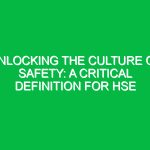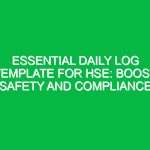Introduction
Hello team, and thank you for gathering today for this important Toolbox Talk. Today, we will focus on a crucial aspect of our daily operations: How Observant Are You?. Our ability to observe our surroundings directly impacts our health, safety, and Environment (HSE) awareness. By enhancing our observational skills, we can significantly reduce the risk of accidents and create a safer workplace for everyone.
Understanding the Importance of Observation in HSE
Observation is more than just looking around; it’s about being aware of your environment, recognizing potential Hazards, and understanding how factors may affect your Safety and the Safety of your colleagues. When we talk about How Observant Are You?, we are emphasizing the need to be proactive rather than reactive. This means identifying risks before they lead to incidents.
The Role of Observation in Preventing Accidents
Statistics show that many workplace accidents occur due to a lack of attention or oversight. For instance, a worker may trip over tools left on the ground simply because they were not paying close attention. By being observant, you can mitigate such risks. Here are some scenarios where heightened awareness can make a difference:
- Identifying Hazards: Spotting wet floors or equipment in disrepair before they cause injuries.
- Recognizing Unsafe Behaviors: Noticing colleagues bypassing safety protocols can prompt immediate intervention.
- Monitoring Environmental Changes: Being aware of changes in weather can help us prepare for potential hazards.
Enhancing Your Observational Skills
So, how can you improve your observational skills? Here are some practical tips:
- Stay Mindful: Practice being present in the moment. This means focusing on your tasks and your surroundings without distractions.
- Conduct Regular Safety Walks: Take time to walk around the work area and observe. Look for anything unusual or out of place.
- Engage with Your Colleagues: Discuss safety observations with your team. Sharing insights can lead to better awareness and solutions.
Real-Life Examples
Let’s consider a couple of real-life scenarios that illustrate the importance of being observant:
Scenario 1: The Slippery Floor
Imagine you are working in an area where a spill has occurred. If you are not observant, you may walk right into it, leading to a slip and fall. However, if you maintain awareness and notice a wet floor sign or the sheen on the ground, you can take Precautions—either by avoiding the area or alerting others to the hazard.
Scenario 2: Equipment Malfunction
Consider a situation where you notice a colleague struggling with a piece of machinery. Their hesitation or frustration may be a sign that something is wrong. By observing their behavior, you can step in to help or report the issue, preventing potential injury and minimizing downtime.
Best Practices for Being Observant
Being observant is not a one-time effort; it requires continuous practice. Here are some Best Practices to incorporate into your daily routine:
- Start Each Shift with a Safety Briefing: Use this time to discuss specific hazards in your work area and remind everyone to stay vigilant.
- Utilize Checklists: Keeping a checklist of potential hazards can help you remember what to look for each day.
- Encourage Feedback: Create an open environment where team members feel comfortable sharing safety concerns.
Addressing Potential Hazards
Understanding potential hazards is crucial for enhancing your observation skills. Here are some common hazards to be aware of:
Physical Hazards
These include anything from uneven surfaces and moving equipment to falling objects. Always be on the lookout for items that can cause slips, trips, or falls.
Chemical Hazards
Familiarize yourself with the chemicals you work with, including their Material Safety Data Sheets (MSDS). Being observant can help you notice leaks or improper storage.
Ergonomic Hazards
Be aware of your posture and the way you lift objects. Observing how you and your colleagues interact with the physical demands of your job can lead to better practices that prevent injuries.
Compliance with Regulations and Standards
Observational skills are not only about personal safety; they also relate to compliance with health and safety regulations. Being observant helps ensure that we adhere to OSHA standards and company policies. Non-compliance can lead to accidents and legal ramifications.
For example, if you notice that safety equipment is not being used correctly, it’s your responsibility to address this issue. Not only does it protect you, but it also safeguards your colleagues and the organization.
Open Discussion: Engaging the Team
Now, let’s take a moment to discuss. I’d like to ask you:
- What are some hazards you’ve observed on the job site recently?
- How do you think we can improve our observational skills as a team?
- Can you share a time when being observant helped prevent an incident?
Your insights are invaluable. Sharing experiences can foster a culture of safety and encourage everyone to be more observant.
Conclusion
In conclusion, today we explored the essential theme of How Observant Are You? in the context of HSE. We discussed the importance of observation in preventing accidents, enhancing our safety practices, and complying with regulations. Remember, being observant is an ongoing practice that requires commitment from each one of us. By actively engaging in our surroundings, we can identify risks before they escalate and contribute to a safer work environment.
Thank you for your attention and your ongoing commitment to safety. Let’s keep our eyes open and work together to ensure that we all go home safe at the end of each day.


